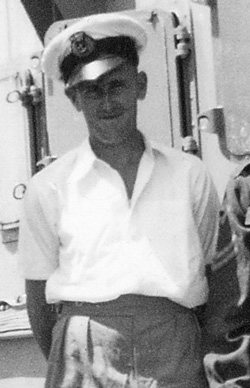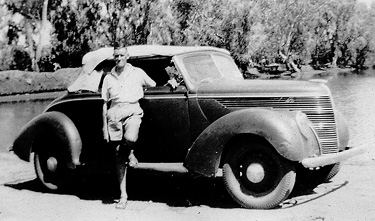
Left: Keith W. Alston returning to Australia aboard the Aquitaina in 1941.
(Photo: K.W. Alston collection)
Keith W. Alston obtained a Second Class Wireless Operator's Certificate
of Proficiency in 1938 after studying with the Marconi School of Wireless
in Melbourne and completing his practical course at the Marconi School
in Sydney.
He worked in commercial radio broadcasting at 3YB and 3GL while studying for his First Class Certificate, which he obtained in 1939.
In 1940 Keith Alston worked for the Post Master General's Department in Melbourne on the carrier telephone system before joining Amalgamated Wireless Australasia (AWA) and going to sea in late 1940. A merchant mariner, Keith was wounded in action whilst serving in the Mediterranean and was invalided home.
AWA was pressing for him to return to sea, on a trip to Hong Kong, but Keith felt that he had not recovered sufficiently. He therefore approached DCA for a job. With the aid of a walking stick he attended an interview with Mr Badenach, DCA's Chief Electrical Engineer, where he was offered, and accepted, a position at Halls Creek, Western Australia.
Normally first appointees paid their own fares to the place of appointment. This was reimbursed after a satisfactory probationary period of service. Keith, however, was lucky. The Department conceded that it would be beneficial for new appointees to receive some meteorological training, as Aeradio Operators would be required to make weather observations at stations where no Met staff existed. The Bureau of Meteorology agreed to conduct the training, but only for people who were actually employed. As a result, Keith was placed on the Head Office staff and his fares were pre-paid. He commenced duty with DCA in June 1941.
Keith's met training, of one month's duration, was completed in Darwin. To get there, he travelled by train to Sydney, then by Qantas Empire Airways (QEA) Empire Flying Boat to Darwin, stopping overnight en route in Townsville. To get to Halls Creek, Keith flew via Wyndham in a Macrobertson Miller Aviation Co. (MMA) Lockheed 10. At Halls Creek, Keith Alston relieved Bruce Acland.
Life in Halls Creek was very basic and during that period aircraft movements at Halls Creek were few, although the Aeradio Operators were required to be on duty for overflying traffic. After 18 months service, Keith went home on leave.
On completion of his leave, during which he was married, Keith resumed duty at Essendon but was only there for one month before he was posted to Concurry, in central Queensland. To get to Cloncurry, Keith travelled by DC-3 to Brisbane and then by QEA DH86 to Cloncurry via Roma.
Keith Alston arrived in Cloncurry in January 1943. At that time the population of Cloncurry was some 3,000, mainly American and Australian Service personnel. The RAAF shared the Aeradio building and provided their own radio network. The town power supply was direct current but DCA provided AC power to all aerodrome users. It was the duty Operator's lot to change from one diesel generator to the other at midnight each day. It was too hot to do it during the heat of the day.
Keith did not settle well at Cloncurry. He suffered from dengue fever, the heat was unbearable, the accommodation at the Hotel cost most of his wages and the workload was high. His Morse speed had suffered during his stay at Halls Creek and he had difficulty keeping up. After three months he asked to be relieved and in May 1943 was posted to Nhill, Victoria.
Keith remained at Nhill until August 1943, when he was posted to Townsville, Queensland, where he worked on he Control Launch at the Flying Boat Base. QEA was still operating Empire Boats to Townsville and there was significant RAAF flying boat traffic. Despite efforts to transfer to Garbutt, the land aerodrome at Townsville, Keith remained for 13 months at the water aerodrome before once again going on leave, in September 1944. Whilst on leave, he was offered a job in Melbourne with a radio manufacturer, but under the wartime manpower regulations he could not be released. He returned to Townsville and worked at Garbutt until September 1945.
Before proceeding on leave again in 1945, Keith was appointed to Kempsey, New South Wales, but he never got there. He was asked to cut his leave short and proceed to Longreach, Queensland, for six weeks. Whilst there, the man who had relieved him at Townsville had an altercation with the OIC and was fined £5 by the Public Service Board. Keith returned to Towsville to relieve his relief!
During 1946, Keith relieved at Cairns twice and Cooktown, then went to Bundaberg to take over the station from the RAAF. He stayed three months in Bundaberg before re-commencing his recreation leave that had been interrupted in 1945.
Following his leave, Keith relieved at Adelaide/Parafield until February 1947, then went to Broken Hill, NSW, for four months. Returning to Essendon, he also relieved at Mangalore, Vic, before proceeding to King Island, in Bass Strait, as the Operator there had been rushed to hospital with appendicitis.
In March 1953 he relieved at Flinders Island, also in Bass Strait, and later that year transferred to Head Office, firsly at Olderfleet and later at Henty House. He operated the teletype system and worked in the frequency allocation section.
In 1959 Keith transferred back to Essendon, and worked there and at Melbourne/Tullamarine until retirement in 1980. He had completed 39 years service. Keith Alston made the proud claim of having served at more stations than any other Aeradio Operator; some 15 in all.
This biography is based on an interview with Keith Alston conducted on 21 August 1984 by Mr K Bentley for the CAHS.
Right: Keith Alston by the river in Cloncurry, Qld, in 1943. The vehicle is a 1938 Ford.
(Photo: K.W. Alston collection)

Back to the main Departmental People Index
If this page does not have menu bars at top and left, click
here